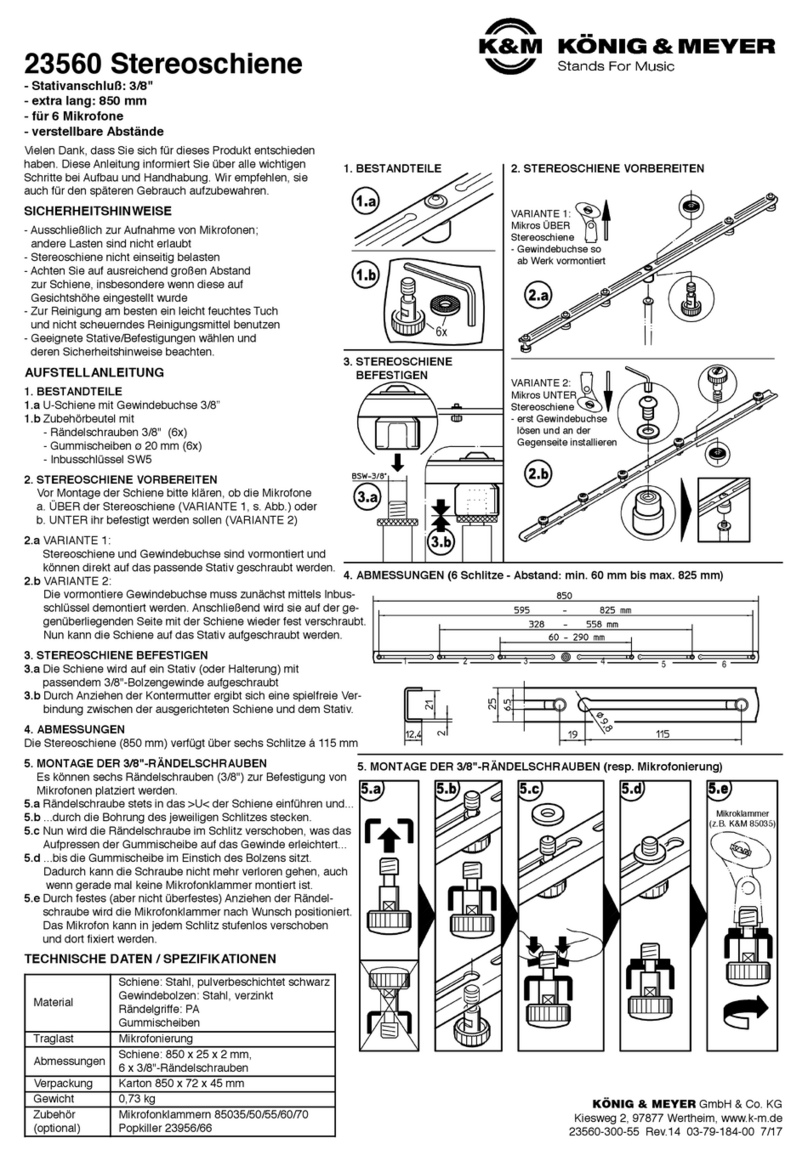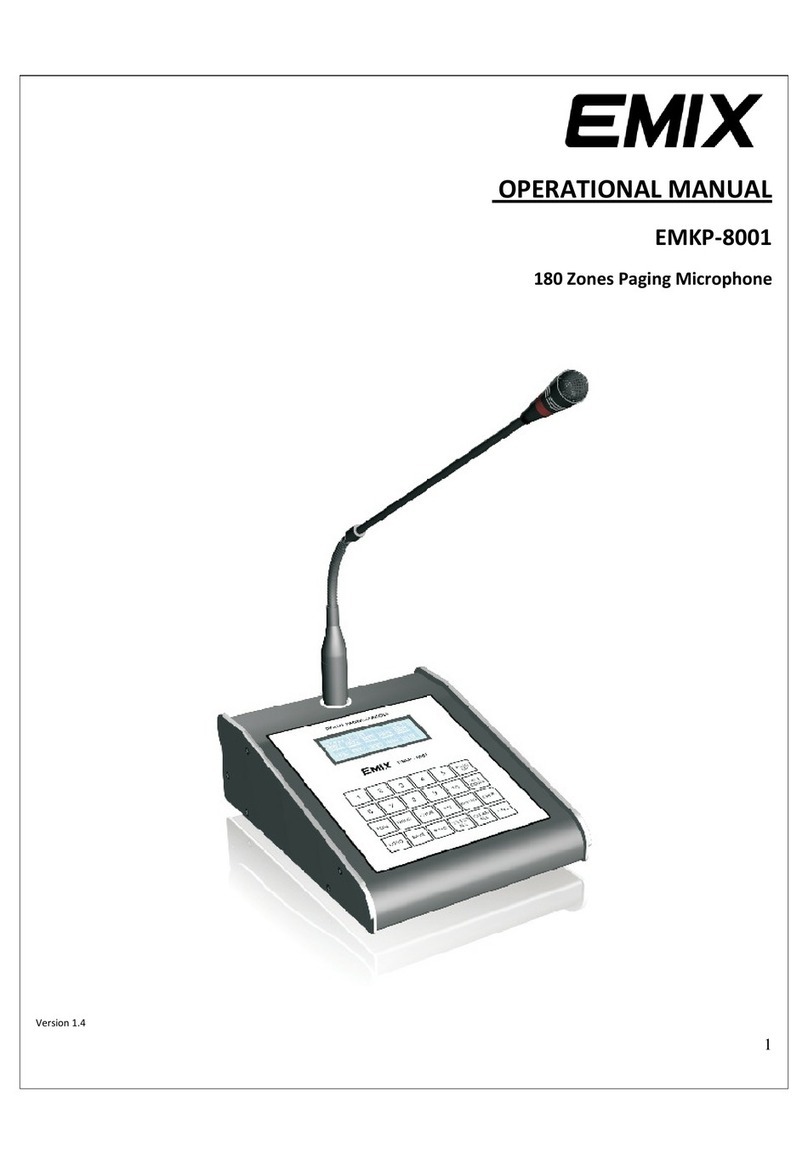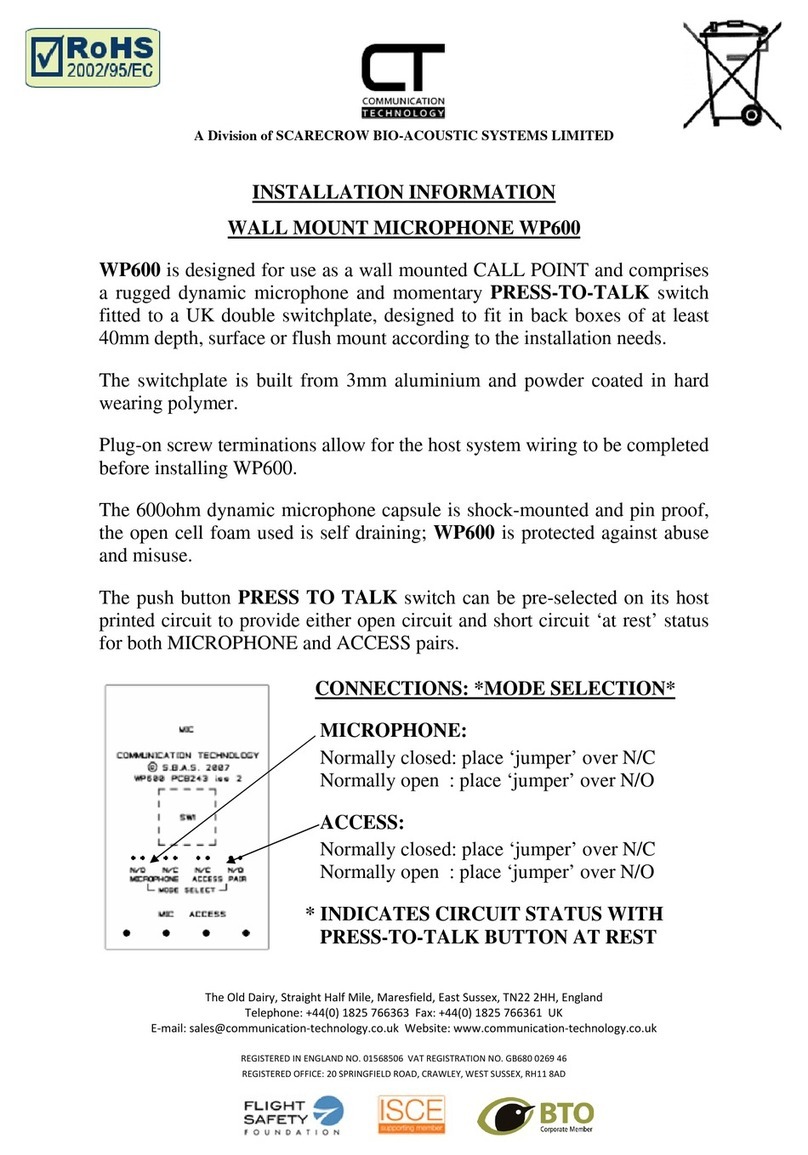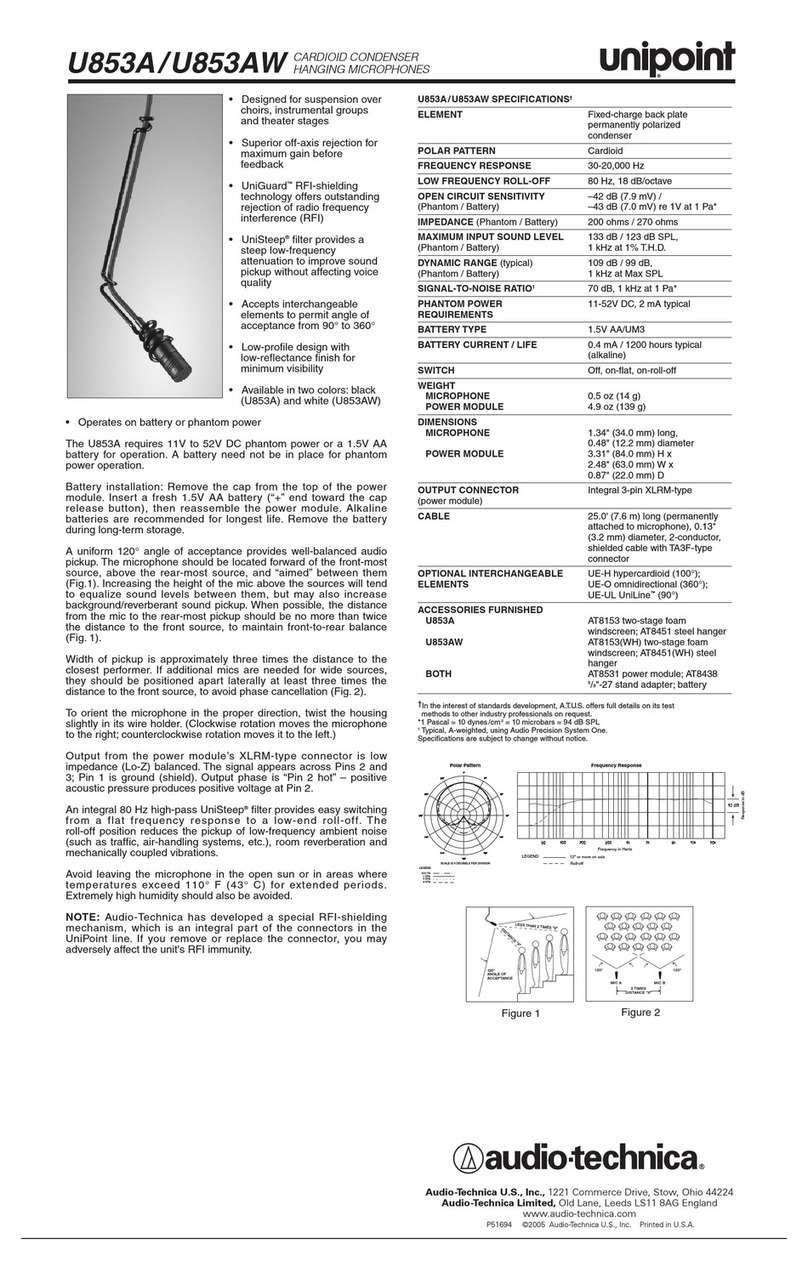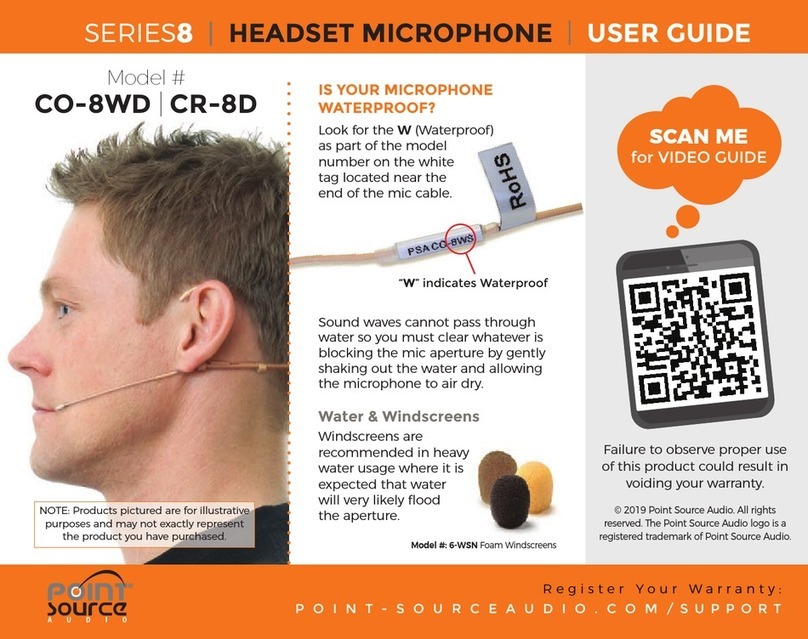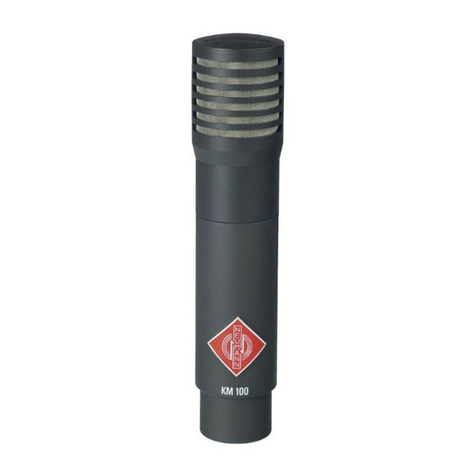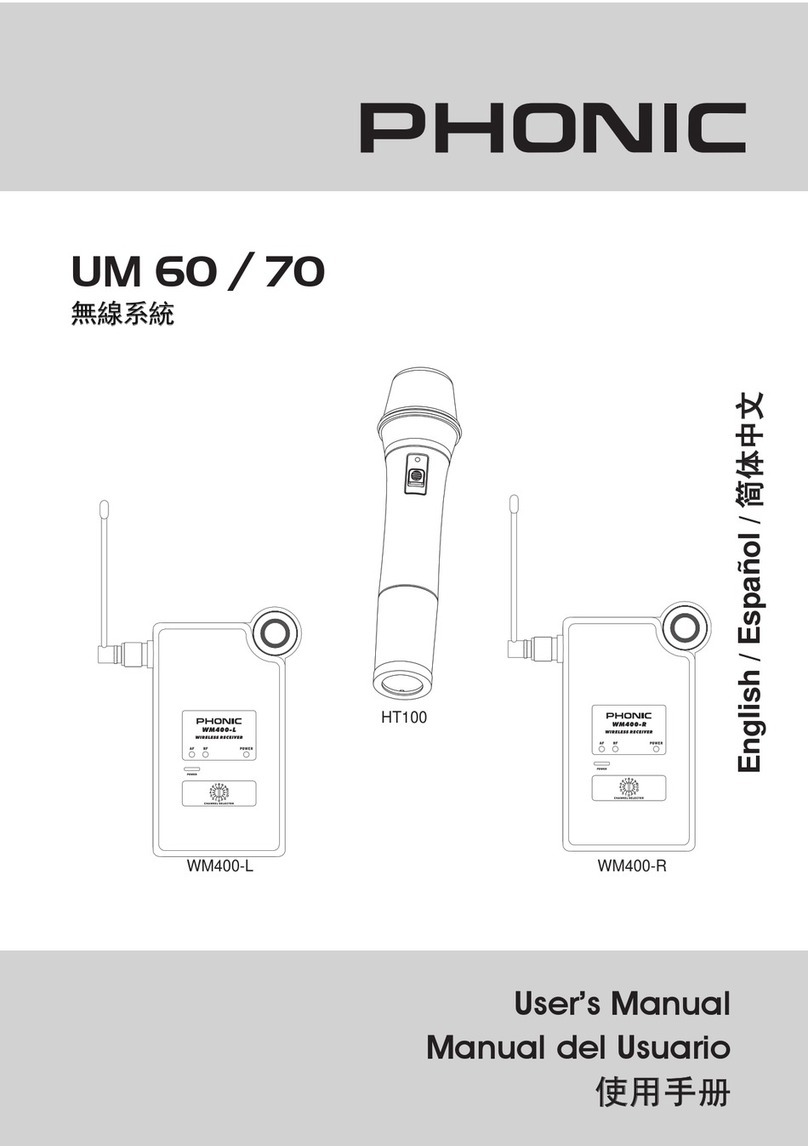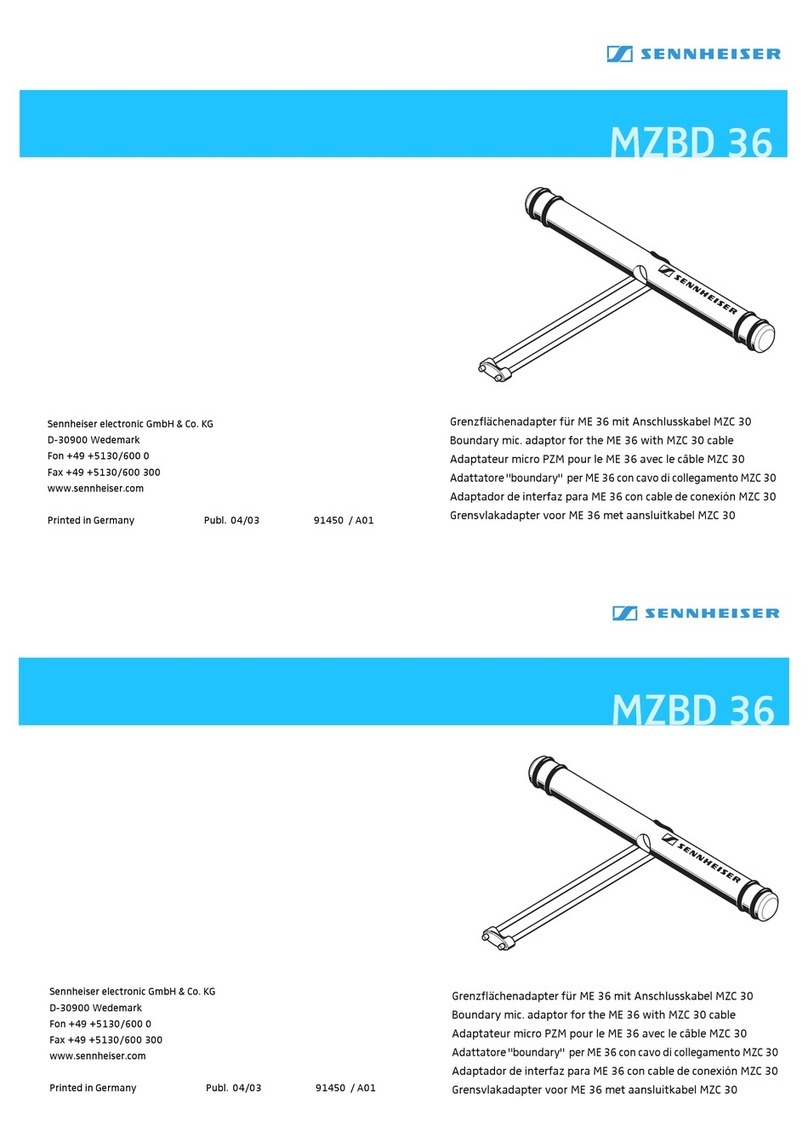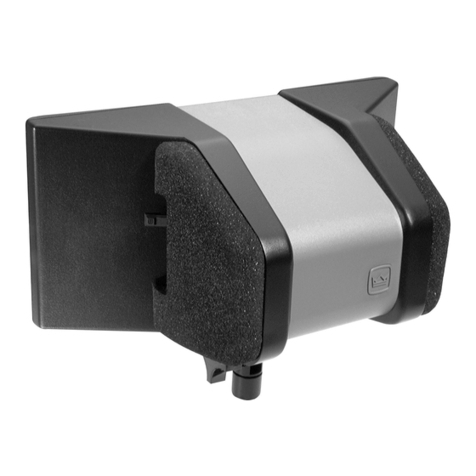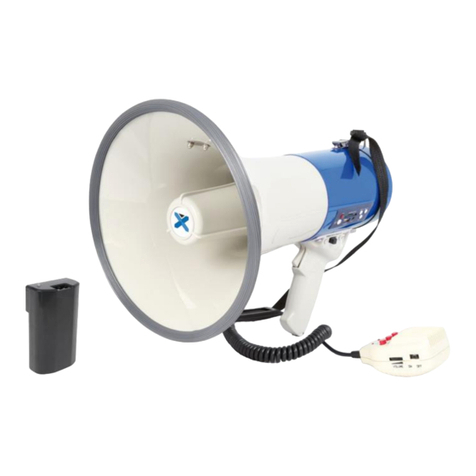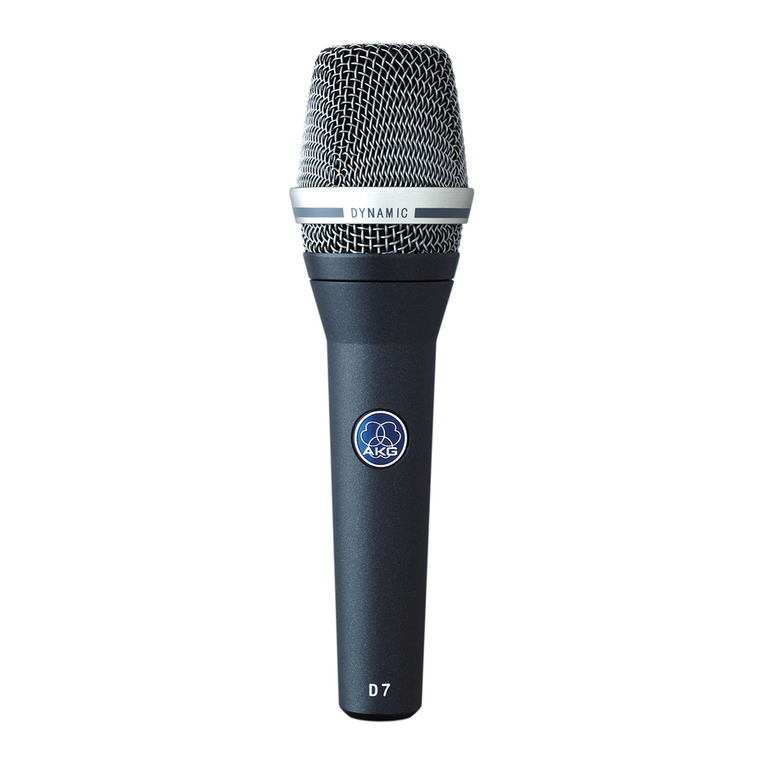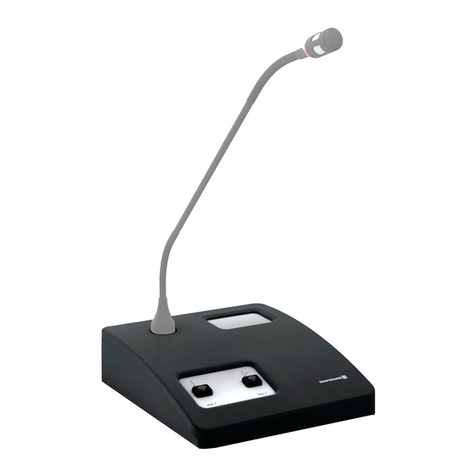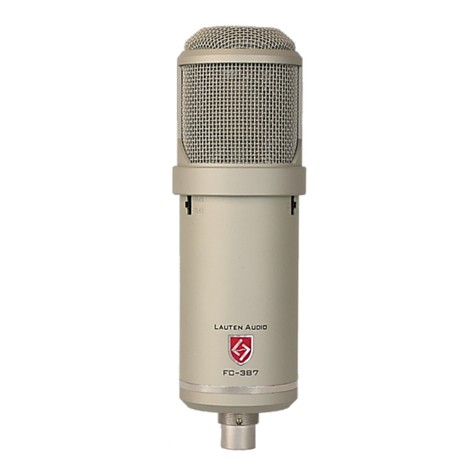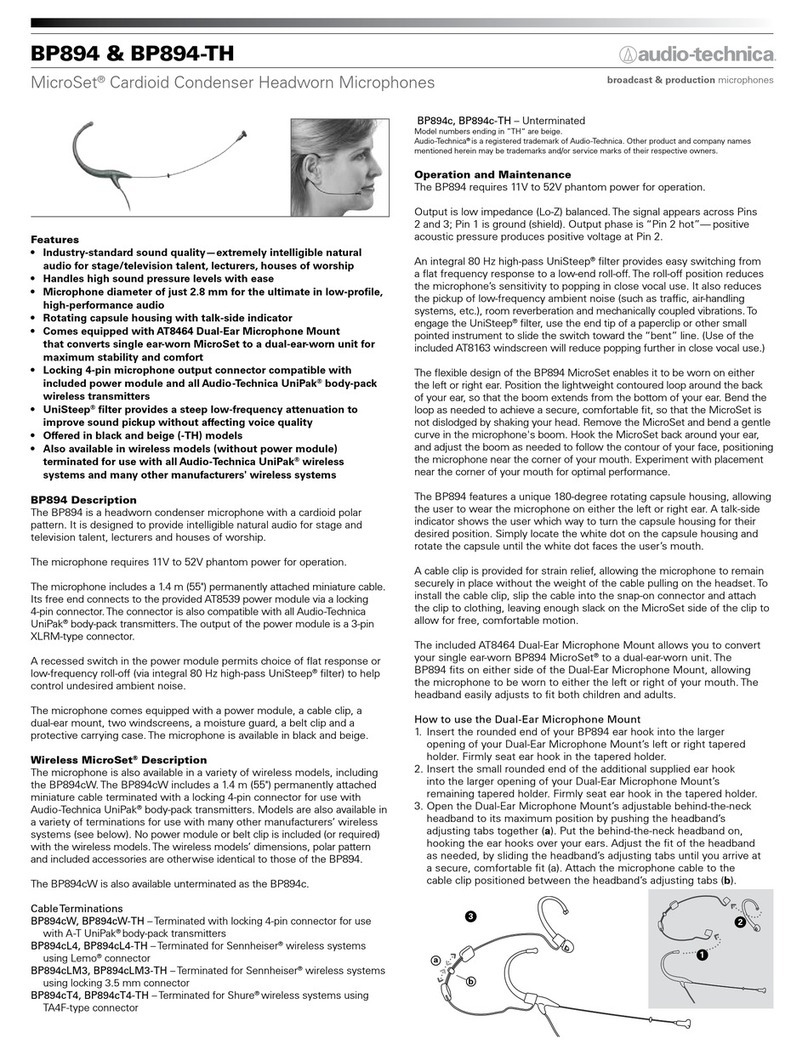Konig & Meyer 23770 User manual

23770 Mikrofonangel
- zur manuellen Positionierung von Mikrofonen über Entfernungen bis zu 5 m
- trägt im ausgefahrenen Zustand Mikrofone bis zu 0,5 kg
- extrem geringes Gewicht und doch stabil dank hochwertiger Fiberglasrohre
- Mikrofonkabel (max. ø 6 mm) kann im Inneren der Rohre platziert werden
- gepolstertes Griffrohr ø 38 mm
- ideal für den mobilen Einsatz: leicht und klein zusammenlegbar
- Länge: min. 1200 / max. 4600 mm; Gewicht: 0,8 kg; Anschlüsse: 3/8" und 5/8"
SICHERHEITSHINWEISE
- Traglast: Mikrofone bis zu max. 0,5 kg
- Das Hantieren mit einer bis zu 4,6 m langen Mikrofonangel bedeutet eine nicht unerhebliche
- Gefährdung für beteiligte Personen. Das gilt auch für Gegenstände die sich in Reichweite
- befinden, wie z.B. Aufbauten, Lampen, Leitungen etc. Entsprechend vorsichtige Handhabung
- ist unbedingt erforderlich.
- Auch eine nicht unmittelbar benutzte Mikrofonangel kann sich als Gefahrenquelle erweisen,
- z.B. als Stolperfalle, wenn sie in ausgefahrenem Zustand abgelegt wurde. Nach Gebrauch
- sollte die Rohrkombination also unverzüglich eingefahren werden.
- Nach dem Einfahren der Rohre diesen Zustand durch Festdrehen der einzelnen Stellringe
- sichern. So wird das unbeabsichtigte Ausfahren der Mikrofonangel ausgeschlossen.
- Bei Verwendung eines innen verlaufenden Kabels darauf achten, dass dieses an den
- Kabelöffnungen nicht abgeknickt wird. Im Lieferumfang ist keine Verkabelung enthalten.
- Sollten Sie mit einer Innenverkabelung arbeiten wollen, empfehlen wir das Kabel am Ausgang
- mit einer Zugentlastung zu versehen bzw. mittels Klebeband gegen ungewolltes Einziehen zu
- sichern.
- Der Bediener muss in der Lage sein mit der Mikrofonangel verantwortlich umgehen zu
können.
ZUBEHÖR
Die Mikrofonangel wird in einer praktischen Umhängetasche ausgeliefert.
Im K&M- Lieferprogramm finden Sie Mikrofonklammern unterschiedlicher Größe
die auf das Anschlussgewinde der Angel aufgeschraubt werden können:
Art.-Nr. passend für Mikrofongrößen
85035 ø 17 - 22 mm
85050 ø 22 - 28 mm
85055 ø 28 - 34 mm
85060 ø 34 - 40 mm
Vielen Dank, dass Sie sich für dieses Produkt entschieden haben. Diese Anleitung informiert
Sie über alle wichtigen Schritte bei Aufbau und Handhabung. Wir empfehlen, sie auch für den
späteren Gebrauch aufzubewahren.
PRÜFEN, INSTANDHALTEN, REINIGEN
Zur Reinigung am besten ein leicht feuchtes Tuch und ein nicht scheuerndes
Reinigungsmittel benutzen.
FEHLERSUCHE (F) und BESEITIGUNG (B)
F: Rohr(e) lassen sich nicht vollständig ausfahren
F: B: Klemmring(e) mehr öffnen
F: Rohr(e) fahren nicht ein trotz geöffneter Klemmringe
F: B: Rohre durch gegenseitiges Verdrehen lösen
F: Kabel stellt sich beim Einfahren der Rohre "quer"
F: B: Kabel an Grundrohröffnung fassen und sanft ziehen bis Rohre einfahren

HINWEISE FÜR DEN BENUTZER
A Handhabung - mit außen verlaufendem Kabel
A.a. KABELMONTAGE
A.a. - erfolgt im ausgefahrenen Zustand der Rohrkombination
A.a. - Kabel um ausgefahrene Rohre wickeln und mit geeigneten Mitteln sichern (z.B. Klebeband, o.ä.)
A.b. ROHRE AUSFAHREN
A.b. Die Feststellringe müssen stets um 1-2 Umdrehungen gelöst werden bevor die Rohre vollständig
A.b. ausgezogen werden können.
A.b. Dabei NICHT alle Ringe auf einmal lösen. Besser geht es so:
A.b. - größten Ring losdrehen, das freigegebene Rohr ausfahren, Ring wieder festdrehen =(1)
A.b. - nächst größten Ring lösen, Rohr ausfahren, Ring festdrehen =(2), =(3), =(4) bis die gewünschte
A.b. - Länge erreicht ist
A.b. - Kabel um Angel wickeln und Mikrofon auf Anschlussgewinde (3/8") schrauben bzw. in Klammer
A.b. - stecken
A.c. ROHRE EINFAHREN
A.c. - Mikrofon abschrauben bzw. aus Klammer entfernen, Kabel aufwickeln
A.c. - kleinsten Ring losdrehen, das freigegebene Rohr komplett einfahren, Ring wieder festdrehen
A.c. - nächst kleineren Ring lösen, Rohr einfahren, Ring festdrehen, usw. bis die Angel komplett
A.c. - eingefahren ist
B Handhabung - mit innen verlaufendem Kabel
- Die Mikrofonangel ist komplett montiert und sofort einsatzbereit.
- Die Materialauswahl sowie der konische Aufbau der Rohre ermöglichen maximale Reichweite
- bei minimalem Gewicht. Daraus folgt eine Handhabung die sich etwas unterscheidet von der
- herkömmlicher Mikrofonangeln. Wir empfehlen deshalb, sich zunächst ohne Mikrofon mit der
- Handhabung der Angel vertraut zu machen.
- Das betrifft z.B. die Wirkungsweise der Klemmringe und das Verhalten beim Aus- bzw.
- Einfahren der Rohre. Erst wenn Sie Sicherheit im Umgang erlangt haben, sollte das Mikrofon
- an die Angel montiert werden.
- Kabelöffnungen ermöglichen den Einsatz eines im Innern der Angel verlaufenden Kabels
- (Kabel bitte in gerader Form; Spiralkabel nicht geeignet).
B.a. KABELMONTAGE
B.a. - erfolgt im eingefahrenen Zustand der Rohrkombination
B.a. - Grundrohrkappe (5) abschrauben; danach Kabel in die obere
B.a. - Öffnung (am Mikrofon) einführen und durchschieben bis es am
B.a. - Grundrohr auftaucht und vorsichtig durchgezogen werden kann.
B.a. - Dabei Kabel an oberer Öffnung behutsam nachführen.
B.a. - Kabel durch Grundrohrkappe schieben und diese wieder
B.a. - aufschrauben
B.a. - Kabel -falls biegsam genug- durch den seitlichen Schlitz der Kappe
B.a. - abführen, da dieser das Kabel (max. ø 6 mm) vor Druck- und
B.a. - Knickstellen während der Benutzung schützt (6)
B.a. - Nach erfolgter Montage sollte das Kabel an der oberen Öffnung
B.a. - (am Mikrofon) gegen ungewolltes Einziehen sowie Druck- und
B.a. - Knickstellen gesichert werden. Dazu an das Kabel angepasste
B.a. - Zugentlaster oder geeignetes Klebeband benutzen.
B.b. ROHRE AUSFAHREN siehe A.b
B.c. ROHRE EINFAHREN
B.c. - Mikrofon abschrauben bzw. aus Klammer entfernen,
B.c. - beginnend mit dem kleinsten Ring alle Ringe der Reihe nach
B.c. - losdrehen und die dazugehörigen Rohre jeweils kurz einziehen
B.c. - (ca. 5-10 cm), Ringe im gelösten Zustand belassen
B.c. - Kabel an der unteren Kabelöffnung fassen und sanft ziehen, so dass
B.c. - sich das Grundrohr behutsam über die gelösten Rohre schiebt,
B.c. - solange bis die Rohrkombination komplett eingefahren ist; bei
B.c. - Bedarf an den Rohren direkt nachfassen.
B.c. - BEACHTE!
B.c. - Das Kabel darf dabei an der oberen Öffnung nicht gequetscht
B.c. - werden.
B.c. - Ringe fesziehen
B.c. - Kabel aufrollen und sichern KÖNIG & MEYER GmbH & Co. KG
Kiesweg 2, 97877 Wertheim, www.k-m.de
23770-000-55 Rev.01 03-80-125-00 9/19

23770 Microphone fishpole
- extends to a max. boom of 5 m, used to manually position microphones
- fully extracted can support microphones up to 0.5 kg
- very low weight, nonetheless stable due to high quality fiber glass sections
- hollow sections allow microphone cable (max. ø 6 mm) to pass through the rod
- padded hand grip section ø 38 mm
- simple to transport: light and retracts to small rod
- length: min. 1200 / max. 4600 mm; weight 0.8 kg; 3/8" and 5/8" thread
SAFETY INSTRUCTIONS
- load: microphone max. 0.5 kg
- be very careful when manoeuvering the fishpole, handling a max. 4.5 m long microphone
- telescopic fishpole presents a significant danger to the handler, objects in the immediate area,
- e.g. superstructure, lighting, electricity cables, etc.
- even when not in use, an extended microphone fishpole may also be a danger, e.g. you could
- potentially trip over it. After use, it must be retracted immediately.
- secure the fishpole when contracted by tightening the locking collars to prevent unintentional
- extension of the rod.
- if a cable has been fed through the fishpole, be careful that the cable is not kinked at the cable
- opening. Cable is not included in the delivery. If you intend using an internal cable, we
- recommend that you use a strain stopper or adhesive tape at the cable exit opening to relieve
- strain and prevent the fishpole from unintentional retraction.
- the microphone user must know how to operate the microphone fishpole.
- the microphone may only be mounted once the fishpole has been extended and must be
- removed before the fishpole is retracted.
ACCESSORIES
The microphone fishpole is delivered in a practical shoulder bag. The K&M
product range includes a variety of microphone clamps which can be screwed
onto the rod:
Item No. suitable for microphones
85035 ø 17 - 22 mm
85050 ø 22 - 28 mm
85055 ø 28 - 34 mm
85060 ø 34 - 40 mm
Thank you for choosing this product. The following instructions show you the main steps in
setting up and using the telescopic fishpole. We recommend that you keep the instructions so
you can refer to them later.
CHECKING; MAINTENANCE; CLEANING
To clean, use a slightly damp cloth and non-abrasive cleaner.
FAULT DETECTION (F) and ELIMINATION (E)
F: Difficulty in fully extending sections
F: E: Further loosen locking collar(s)
F: Sections still will not freely extend.
F: E: Loosen sections by twisting in opposite directions.
F: Cable twists horizontally when retracting the sections
F: E: Hold the cable at the largest section and retract the sections while exerting a
F: E: continuous and gentle pull on the cable.

INFORMATION FOR THE USER
A HOW TO USE WITH AN EXTERNAL CABLE
A.a. ATTACH CABLE
A.a. - attach cable when fishpole is extended
A.a. - wrap the cable along the extended fishpole and secure by suitable means (e.g. adhesive band, etc.)
A.b. TELESCOPICALLY EXTEND SECTIONS
A.b. The locking collars need to be loosened 1-2 twists before extending the sections fully.
A.b. Do not loosen all the locking collars at once. It is better to:
A.b. - loosen the largest locking collar first, extend the first section, tighten the locking collar =(1)
A.b. - loosen the next largest locking collar, extend the section, tighten the locking collar =(2), =(3), =(4),
A.b. - until you have the rod length you require
A.b. - wrap the cable along the rod and attach the microphone to the end thread (3/8”) or clamp
A.c. RETRACT SECTIONS
A.c. - unscrew/unclamp microphone, remove cable
A.c. - loosen the smallest locking collar, fully retract the loose section, re-tighten the locking collar
A.c. - loosen the next smallest locking collar, retract the section, and tighten the locking collar, etc. until
A.c. - the fishpole is fully retracted.
B HOW TO USE WITH AN INTERNAL CABLE
- the microphone fishpole is delivered ready to use.
- the materials used for the sections together with their conical construction give max. extension
- with min. total weight. However, the method for retracting and extending the rod is unlike that
- of more conventional microphone fishpoles. We recommend that you familiarize yourself with
- the functioning of the locking collars and how to extend and retract the rod. Do not attach the
- microphone until you feel comfortable with the functioning of the fishpole.
- A cable can be run internally through the fishpole from the cable opening (not suitable for spiral
- cables)
B.a. INSERT CABLE
B.a. - when the fishpole is retracted
B.a. - unscrew the base cap (5) and insert the cable into the upper hole (at
B.a. - the microphone) and push through until it reaches the largest section
B.a. - and can carefully be pulled through while cautiously supplying more
B.a. - cable to the upper opening.
B.a. - push the cable through the base section cap and then replace the cap
B.a. - if the cable is sufficiently flexible, lead it through the slit in the side of
B.a. - the cap, which will stop the cable (max. ø 6 mm) being flattened or
B.a. - kinked. Fit a strain stopper or use suitable adhesive tape.
B.b. TELESCOPICALLY EXTEND SECTIONS see A.b.
B.c. RETRACT SECTIONS
B.c. - unscrew or unclamp the microphone
B.c. - beginning with the smallest locking collar, loosen all the locking
B.c. - collars, one after another and retract each section about 5-10cm,
B.c. - leave the locking collars loose
B.c. - hold the cable at the cable opening and carefully push the base
B.c. - section over the loosened sections until all the sections are
B.c. - retracted. If necessary hold on to the sections.
B.c. NOTE!
B.c. The cable must not be squashed at the upper opening.
B.c. - tighten the locking collars
B.c. - roll up the cable and secure
KÖNIG & MEYER GmbH & Co. KG
Kiesweg 2, 97877 Wertheim, www.k-m.de
23770-000-55 Rev.01 03-80-125-00 9/19
Table of contents
Languages:
Other Konig & Meyer Microphone manuals
